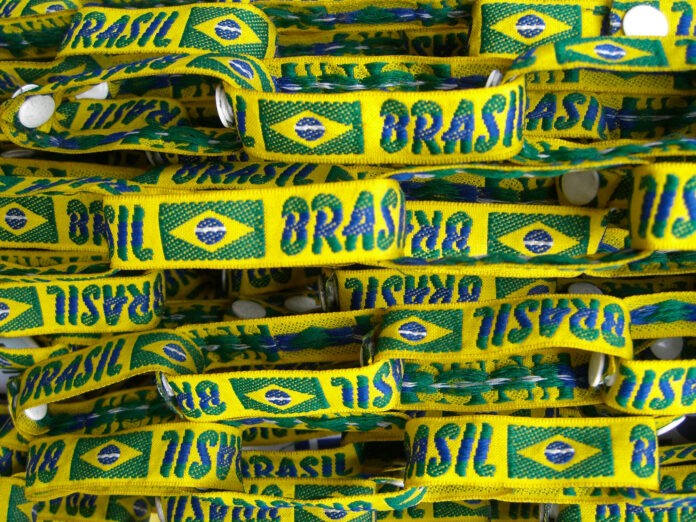Trend driven by eucalyptus fibre resources, efficient plantations and mills with much room for further expansion, seven new machines under construction, and substantial increases in consumers’ personal income. Report by Bruce Janda, Senior Consultant, Fisher International.

Portuguese-speaking Brazil escaped the fracturing experienced by the Spanish-speaking countries of Latin America in the colonial period, retaining its size and unique culture. Avoiding fracturing increased the scope of natural resources and climates available for development compared to its smaller neighbours. However, it also resulted in a somewhat different tissue culture. For example, Brazilians didn’t flush their used tissue paper but instead collected it in rubbish bins by the toilet.
Brazil continues to expand its tissue production and resulting exports each year. We noted the country appeared to make the switch from tissue importer to exporter when we last visited Brazil in this column in 2021, post-pandemic. The country continues to be a global tissue pulp leader with substantial eucalyptus plantations. However, it is now capturing increased value through added tissue production at home and then exporting the finished products. This is a sound manufacturing strategy to get the most value from the eucalyptus fibre resources from highly efficient plantations and pulp mills. However, it does increase the shipping cost and carbon footprint as soft and bulky tissue products consume shipping containers or cubic meters disproportionately to the product weight, unlike packaging paper or market pulp grades.
Brazil’s population is estimated at 218,689,757 in 2023, making it the sixth most populous nation with the seventh largest land mass globally. Figure 1 shows the population trend as a yellow line. The population growth rate is estimated at 0.64% for 2023. This slowing population growth is one reason Brazil looks to tissue exports for manufacturing growth. Also, its workforce is relatively young compared to more fully developed countries.
The country’s economy grew at a rate of 4.62% in 2021. The bars in Figure 1 show GDP per capita growth at purchasing power parity to facilitate global comparison. The post-Covid-19 recovery and growth are shown in Figure 1. Years 2021 and 2022 saw substantial increases in personal income that should support further domestic tissue growth, especially in other tissue formats such as paper towels.
Brazil’s recent experience with unemployment and inflation is shown in Figure 2. Inflation hit a peak in 2022, but 2023 data indicates some improvement, along with unemployment. These trends should help further support the further development of domestic tissue demand.
Figure 3 shows Brazil’s tissue import trend. Tissue imports dropped dramatically since 2013. Recently, Columbia and China supplied the largest share of imports, with smaller amounts from South Korea, Germany, and the United States. Its import volume in 2022 was about one-sixth of the rate in 2007.
Brazil’s tissue export trend shows strong growth, as seen in Figure 4, as tissue exports now greatly exceed imports. The 2022 import volume is about 3.5% of the 2022 export volume. Brazil’s tissue export customer focus includes its Latin American neighbours of Chile, Argentina, Uruguay, and Paraguay, with lesser volumes to Mexico.
Brazil has added significant tissue capacity since 2007. Total tissue capacity by 2025 is expected to reach more than 2.2 times the 2007 level, as more new capacity is coming online in 2024. This is supported by Figure 5, which shows the country’s tissue machine count change trend for the referenced periods. As we can see, it indicates that seven new machines are under construction. The count change chart tends to understate the impact as the new machines represent a much larger capacity than the old machines going out. For lower costs, several new machines will be located at virgin integrated or recycled integrated fibre sites. Most of Brazil’s tissue production is still consumed at home, and the increased exports represent a small portion of the total capacity so far.
As one of the largest suppliers of export market pulp to the tissue industry, Brazil’s eucalyptus is known worldwide as a critical ingredient for tissue softness and premium quality production for higher margin products. Eucalyptus has several unique properties that maximise tissue formation and the development of free fibre ends at the tissue surface. Yet, at this point, only about 12% of the total Brazilian tissue capacity is produced at integrated virgin pulp sites to take advantage of energy and cost savings from not drying the market pulp for shipment. Figure 6 shows the breakdown of the country’s tissue capacity by site type. Surprisingly, 58% of Brazil’s tissue capacity is located on recycled integrated fibre sites that accrue the same cost savings.
Consumer bath tissue is the most significant product produced by Brazil’s tissue mills. This indicates a lot of room to grow tissue consumption with improved consumer spending power, leading to increased use of disposable napkins and towels in the home. Figure 7 shows each finished product category’s average use of fibre types. Very little softwood is produced or used in tissue by Brazil. This could be a tissue quality or performance issue for competitive tissue exports from the country, as softwood is a crucial ingredient for strength and bulk. However, the newer tissue machines located at the eucalyptus-integrated fibre sites appear more focused on exports.
Figure 8 shows the same finished product fibre makeup as Figure 7 but includes only the eucalyptus virgin fibre integrated sites with some of the newest tissue machines. This guides global tissue makers importing eucalyptus market pulp towards the best use of the fibre in different tissue finished products. For example, commercial napkins and towels contain 100% eucalyptus hardwood fibre. Commercial bath tissue also has eucalyptus fibre, produced as BCTMP, and a trace of softwood pulp. The retail bath uses 18% softwood pulp and 16% BCTMP, presumably for bulk and strength. Consumer napkins and towelling have even higher percentages of BCTMP and some softwood. However, 100% eucalyptus may be cheaper. Still, it is worth using tactical amounts of other fibres to maximise tissue properties in exported products, which can increase profit despite the increased costs.
A comparison set of countries’ tissue machine fleets was chosen based on the regional customers of Brazilian exports, including Argentina, Columbia, and Uruguay. Tissue exporters such as Mexico, Turkey, China, and the United States were also included for comparison. The bubble chart in Figure 9 shows the average quality of the comparison set and Brazil. The size of the bubbles on the graph represents the total tissue capacity for each country. The X-axis represents each country’s average machine technical age, and the Y-axis represents the average machine width. Brazil’s tissue machines are of average technological age while also being narrow. Compared to Indonesia, they average 5-6 years older and almost 100 cm narrower. However, Brazil is updating its tissue machine fleet faster than most countries on the chart, and we should expect continued improvement in these metrics.
The relative average cost of making a finished ton of tissue for the countries in the comparison set is shown in Figure 10. The height of each country’s bar represents the cash cost of production, and the width of each bar is the relative tissue capacity. The coloured bands for each bar represent the costs of raw fibre material, market pulp, chemicals, energy, labour, materials, overhead, and credits. Brazil is in the lowest cost set with Indonesia and Argentina. Mexico and the United States have much higher average costs. Mexico’s energy costs appear very high, and labour in the United States is much higher as well. It’s important to note that these are average costs, and individual machine costs will diverge considerably.
A snapshot of the average tissue machine and mill viability is shown in Figure 11. In this case, the bar height is detailed by viability factors, including:
- Capital required
- Cost
- Grade risk
- Internal company risk
- Competitiveness
- Size
- Technical age
- Tons per unit trim
Brazil’s tissue production does well in this comparison, as it’s positioned on the lower end of the benchmark. However, Columbia and Uruguay are in the high-risk group with lower viability, two countries that have started to import Brazilian tissue.
Carbon emissions per finished metric ton are shown in Figure 12. These are the emissions of the tissue machines only on a site and do not include pulp production on an integrated site. Scope 1 and 2 emissions were chosen as the most likely to be included in a carbon analysis by potential consumers. The colours stacked in each bar represent the source of each emission. The two key areas are fossil fuel consumption on site for power and heat for tissue drying and the fossil fuel content of the electricity grid production. Uruguay and Brazil contain the best results in this chart. China and the United States are positioned as the worst in this set. Carbon emissions depend not only on the choice of electric grid power or mill heat source, ranging from coal to natural gas, but also on the energy efficiency of each machine used to produce the same ton of tissue.
Brazil continues progressing from tissue importer to tissue exporter, focusing on tissue sales to Latin American neighbours, where it enjoys some competitive advantages. Domestically, Brazil’s economy continues to support further consumer tissue consumption development. Additional new tissue capacity coming on stream will further these trends. The country makes good use of its recycled integrated tissue sites but has a lot of room for further expansion at its eucalyptus pulp-producing sites to capture synergies and cost savings for premium exportable products. These existing eucalyptus fibre integrated machines have optimized the furnish of critical grades by including BCTMP for bulk and cost savings. They also use small amounts of softwood for strength and bulk. Significant fibre synergy exists between Argentina and Uruguay as they produce southern softwood pulps that improve the results of high eucalyptus tissue furnishes.
Analysis of competitive position requires specifics on tissue producers and individual machines. This article presents a static summary of Brazil’s tissue industry today. Fibre prices, exchange rates, and environmental regulations will change, providing some participants with advantages and other new challenges. In addition, Brazil’s tissue mills will continue to change hands and consolidate, and neighbouring countries may invest in tissue-making capacity, affecting Brazil’s imports and exports.








































